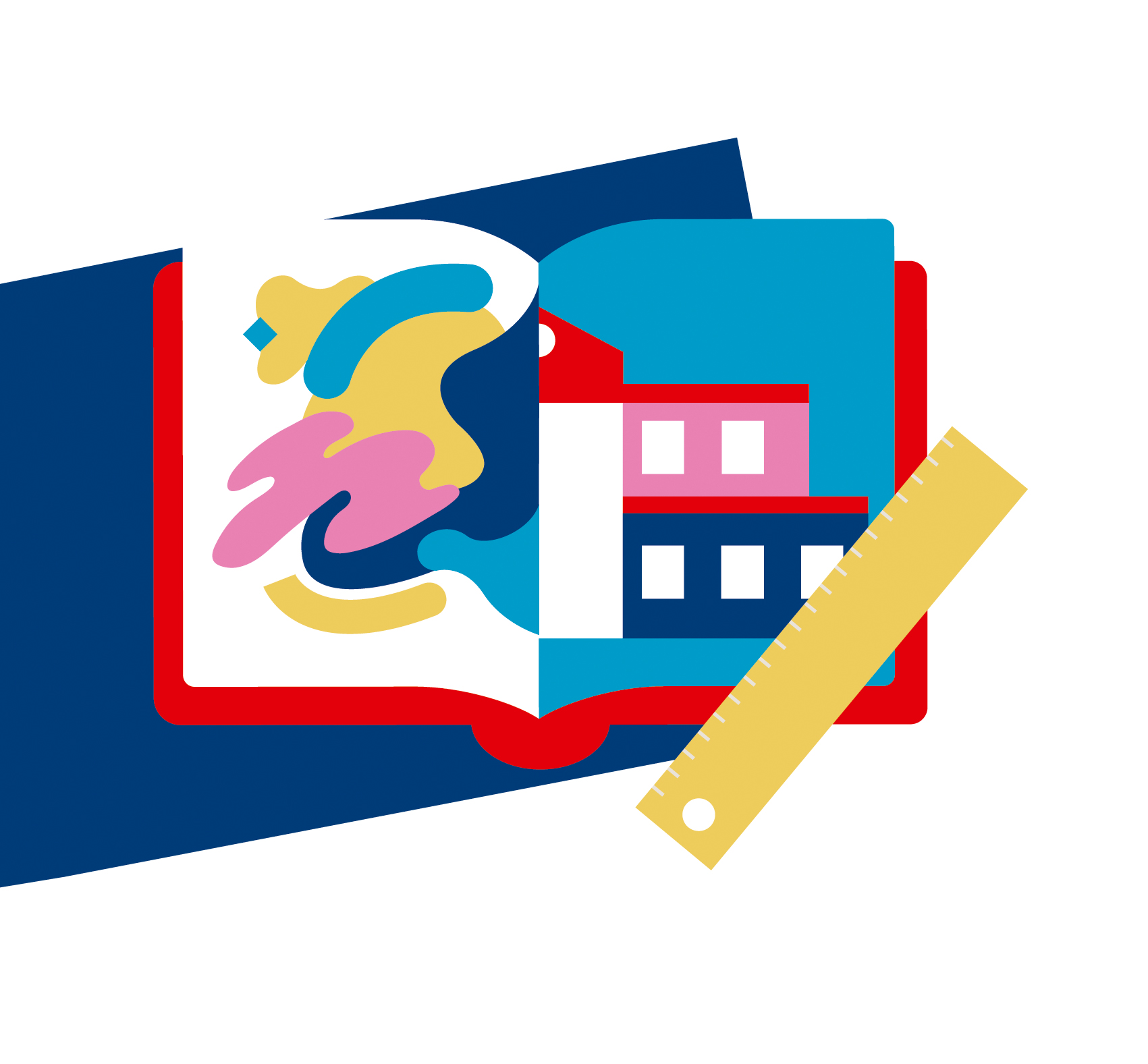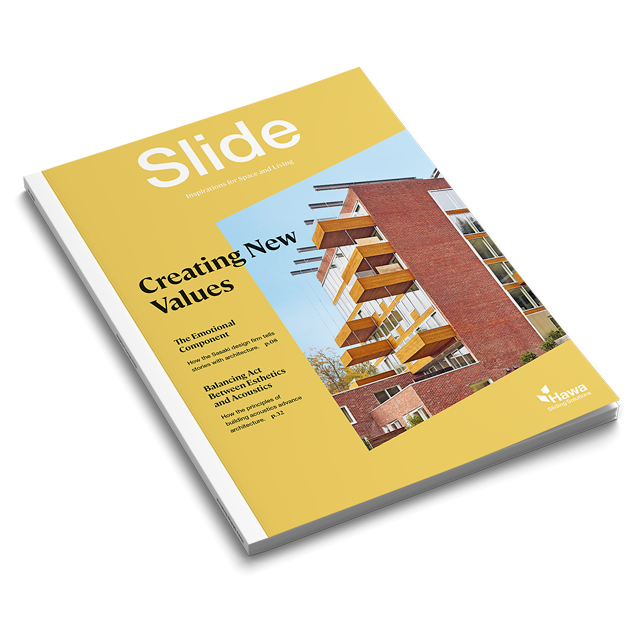
Telling a Story with Architecture
Author: Evelyne Oechslin
Illustration: Daniel Ramirez Perez
Buildings create value. The international design firm Sasaki believes that architecture should benefit society, and that is the reason behind its values-based philosophy. Principal planner Caitlyn Clauson and principal architect Victor Vizgaitis share what that means in practice, why listening makes a difference, and the situations in which they, as supervisors, take charge of the decision-making process.
During the construction process, the focus is often on the financial value of buildings. But this is short-sighted, since architecture can shape our every- day lives and have a major impact on society and the environment—both during construction and long after it is finished. When these perspectives are considered, it becomes clear that there are many different dimensions in which buildings represent value. This view is increasingly present in discussions among architects. This is due in no small part to the sustainability debate, which has changed the way we think about buildings in recent decades. There is also a growing movement in the industry to focus on the beauty of buildings and how they can enrich society. One proponent of this attitude is the architectural firm Sasaki, with offices in Boston, Denver, and Shanghai.
Three dimensions of value
Victor Vizgaitis, principal architect at Sasaki, cites three dimensions in which a building can provide value. First, he says, is usability: “As architects, we can’t just think like artists during the planning process. Functionality must be a given, whether it’s for living, working, or a shared space.” Second, buildings should have an emotional component that goes beyond mere functioning. Vizgaitis calls this “delight,” explaining that “what appeals to us emotionally makes the world a better place.” The third dimension, he says, is a little more difficult to grasp. It concerns the big questions that challenge society: “A building should contribute something to the big picture.”
“A building should contribute something to the big picture.”
His colleague, planner Caitlyn Clauson, picks up on the third aspect, “A building is the manifestation of a vision.” At its best, she says, it is a meeting place, accessible to all. That is why it’s also important to plan inclusively, considering how the building will fit into the public space and landscape. “After all, no building stands alone,” she says.

Universal design considerations
Designing solutions for all generations
requires creativity from everyone involved.
Team diversity since 1953
Value orientation is a tradition at Sasaki. Back in 1953, company founder Hideo Sasaki made a point of embedding each project within its cultural, historical, geographical, environmental, social, and economic context. Today, the work of the architecture firm remains firmly based on these values. “Every project starts with an in-depth examination of the context and this high level of contextuality means that no two projects are the same,” Clauson explains, “That’s why there is no identifiable Sasaki style.”
In addition, an important part of Sasaki’s work has always been the inclusion of a wide range of perspectives. “In the 1950s, that was a fairly new idea,” Clauson says. All teams are made up of experts from Sasaki’s three departments of landscape, architecture, and urban planning. “No one approach is more important than the other,” says Vizgaitis, explaining that projects benefit from this interdisciplinarity, because none of them is the brainchild of just one individual but rather a collective effort. “The members of our diverse teams critically question each other and spur each other on to be better,” explains the architect.
Against the backdrop of this tradition, it is not surprising that three of the five values Sasaki is committed to relate to communication and collaboration: The design firm aims, first, to listen, explore, and learn continuously; second, to provoke new ideas through active, inclusive dialogue; and, third, to promote a diversity of ideas, perspectives, and people.

Values in practice
These values may sound abstract at first, but they translate well into practice. Clauson and Vizgaitis share how their multi-perspective approach works. The basic prerequisite for this is a flat hierarchy where everyone’s ideas are valued as equally important. “It’s all about the best idea—and if that comes from the intern, then we run with it just as much as if it came from the principal,” Victor Vizgaitis explains.
Caitlyn Clauson further describes the work process. Her approach, she says, is always to focus on a narrative, that is, to tell a story in order to get all parties on board. “The briefing at the beginning is crucial. The more clearly we formulate it, the better the solution will be in the end.” At Sasaki, the teams hold regular meetings to work together on clearly formulated goals and milestones.
But the company doesn’t function entirely without hierarchies. There are 30 partners in the company who take on leadership responsibilities and provide motivation for the team. “The goal is consensus. This only works if all employees believe in the story we are working on. So every-one has a stake in contributing to its success,” Vizgaitis says. This is a completely different approach to other offices, where a classic top-down culture is the norm. But if, despite everything, the team fails to reach an agreement, then the partners in their role as leaders would step in to make the decision and bear the responsibility for it.

The five values of Sasaki
Winning clients with storytelling
“It’s also important to consider the context of the clients and partners in the process and in crafting the story,” says planner Clauson. After all, they are also in different positions. In some projects, she says, a board of directors drives the decision-making process, while other projects have a more ground-up consensus-based process. “To be a good storyteller, you also have to be a good listener. We have to understand what the client wants and needs and work out a unique solution from that,” she says.
Most of the time, it’s not hard to convince customers to adopt value-based planning if you show them its benefits, she continues, and Vizgaitis adds, “People tend to be risk-averse. We show them that value-based construction doesn’t necessarily take more time or more money, it just requires more creativity from us.”
«Buildings have a functional and an emotional dimension.»
Combining art and data
The diverse make-up of Sasaki’s teams helps realize the company’s fourth value, which states that the company integrates artistic expression with evidence-based solutions. “Both aspects are important for a good project. Buildings have to function and should have an emotional impact at the same time,” says Vizgaitis. To unite these two aspects, the art of storytelling again comes into play, he says: “We have to think about how to integrate the two in every project and convey that through a compelling story.” Clauson adds that the role of data-driven planning should not be underestimated: “Placing facts on the table helps us make informed decisions and facilitates consensus building.,” she says.
Data also plays an important role when it comes to sustainability. Sasaki’s fifth value is to design and plan for a sustainable, resilient future. With this mindset, the company is aiming to go one step further and set specific, far-reaching goals for aspects such as resource use, decarbonization, planting, and mobility. “Sustainability has become a fundamental element of our work,” says Clauson. Her colleague adds that it is important to remain flexible on this topic, as “the ecological and economic point of view on sustainability is constantly changing. The pandemic in particular showed us that buildings need to be adaptable to remain usable for the long term.”
Remodeling requires creativity
In the interests of sustainability, more and more buildings are being converted rather than demolished. Clauson feels that this is an important development. She admits to liking a challenge, and so enjoys the design constraints that come with such a project. Again, she says, it’s all about flexibility and creative thinking, turning an existing building into something new. “At the beginning of the process, we analyze the building, we ask it whether it’s a candidate for remodeling and what it wants to become. The more we know, the more the building speaks to us,” she says with a grin.
Vizgaitis takes a nuanced approach to the discussion of remodeling and demolition: “This topic tends to elicit the provocative statement that ‘you should never demolish a building.’ But I find this too simplistic,” he says, adding that it makes no sense to subject oneself to such strict restrictions. This is where the aforementioned principle of usability comes into play again. This must always come first. “After all, a building should not be rendered inferior or unusable for its users just to preserve its substance,” says the architect. Sometimes an existing building just doesn’t work for the resident community, he says.
Universal design considerations
There is another reason why construction within existing structures is not a panacea. As Caitlyn Clauson explains, accessible construction is not possible for all existing buildings. In the case of old buildings, such aspects were often simply not taken into account and they cannot be introduced retrospectively everywhere. That is why a new building makes more sense in such cases. It is essential for us to consider this aspect, she says, adding, “I’m very committed to the principles of universal design.” This design philosophy involves planning a project in such a way that it can be used by the greatest possible number of people, and also incorporates the principles of inclusive design. For example, instead of creating a separate entrance for specific users, the main entrance is made accessible to all. Clauson believes that this way of thinking should always be a planner’s first instinct.
“I’m very committed to the principles of universal design.”
Architect Victor Vizgaitis agrees that inclusiveness should always be prioritized, “but that doesn’t mean that it is always going to be possible for every individual to use every space equally well, particularly in reuse projects. Every building is also a building within our world, in the public realm, and it therefore also has a role to play in how we perceive buildings and how they shape our experience outside.” It is therefore good to take principles such as universal design as a point of reference. Ultimately, he believes, this value also requires more creativity from everyone involved, which definitely benefits a project.
The emotional component
Values not only make buildings more usable, more beautiful, and better for society, they also promote creativity. The two Sasaki board members mention this aspect several times in connection with value-based planning. When architecture is more responsive to the individual situation, it ultimately becomes more valuable—in both the concep- tual and monetary sense.
Among all the values Sasaki stands for, do Caitlyn Clauson and Victor Vizgaitis have personal favorites? Are there values they would like to see taken more seriously within the industry? Architect Victor Vizgaitis says that “there is always that desire for the construction process to be faster and cheaper, and often this is at the expense of emotion. That is a pity, because we all have the right to live and work in places we love. We shouldn’t sacrifice the emotional component because that’s giving up an important part of being human.” Clauson makes a special case for the value of inclusivity: “I’d like to see that become a guiding principle for every project.”
Caitlyn Clauson and Victor Vizgaitis
Caitlyn Clauson is chair, board member and principal planner at Sasaki. Her areas of expertise include developing campus master plans, space programming and utilization analyses, and engagement and outreach strategies.
Victor Vizgaitis is chair of architecture and interior design and a board member at Sasaki. With his team, the architect brings together a broad spectrum of disciplines, ranging from architecture and interiors to landscape and urban design.
You can also find the article on Sasaki's value-based architectural approach in our Slide #4. In this issue of the magazine, you will also learn more about the balancing act between aesthetics and acoustics, and we will take you along with us when a barrier-free apartment is planned in Switzerland.
Order the magazine free of charge to your home or download it directly.
